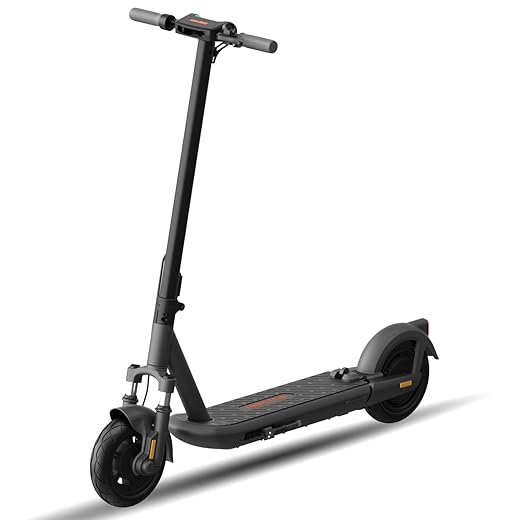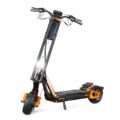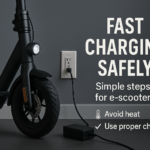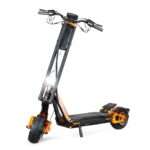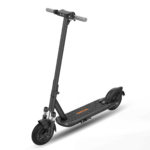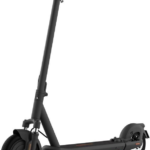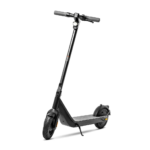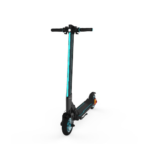- Home
- Scooters
- Electric Scooters
- INMOTION S1
INMOTION S1
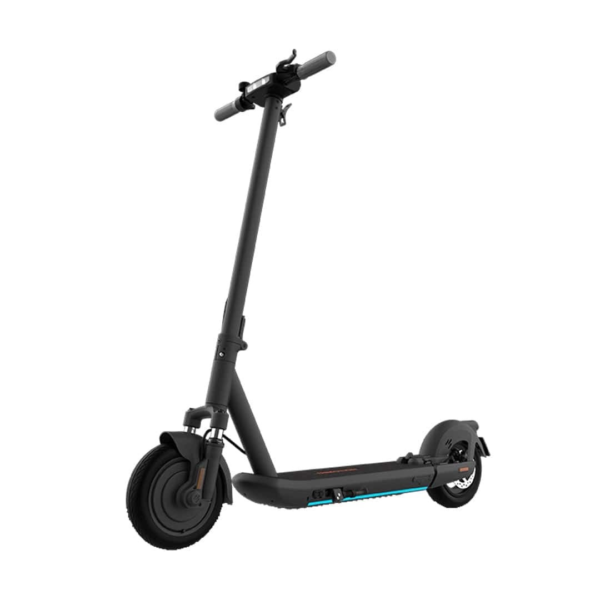

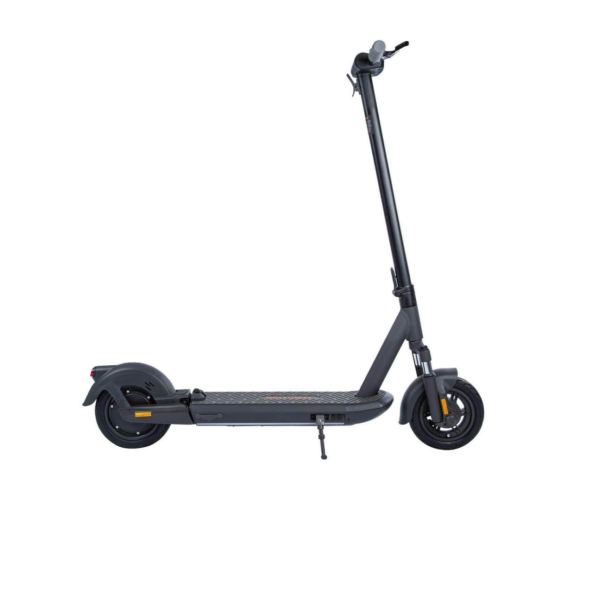

- Battery Range: 59 miles (95 km)
- Top Speed: 18.6 mph (30 km/h)
- Motor Power: 500 W
- Weight Capacity: 308 lb (140 kg)
- Charging Time: ~7 h
- Scooter Weight: 52.9 lb (24.0 kg)
PROS
- 59 miles (95 km) maximum range
- Dual suspension for comfort
- 10″ tubeless pneumatic tires
- 308 lb (140 kg) max rider weight
- Rear-drive 500 W motor
CONS
- Lower top speed than S1F
- Heavy 24 kg (52.9 lb)
- Drum brake feel vs hydraulic
Key Takeaways
- The INMOTION S1 is a long-range commuter scooter designed for comfort and ease of use.
- It features a 10-inch tire, a 500 W hub motor that peaks at 1,000 W, and a 54 V, 12.5 Ah battery with a range of up to 59 miles.
- The scooter includes Bluetooth app compatibility, three ride modes, and strong water protection (IP55 to IPX7).
- With a weight of 52.9 lb, it folds easily for transport and has a stable ride quality with front and rear suspension.
- The INMOTION S1 is ideal for commuters needing reliable performance and safety features, but not for those seeking high-speed thrills.
Table of contents
- What Is the INMOTION S1?
- How the INMOTION S1 Works
- Key Specifications
- Design & Build Quality
- Performance Fundamentals
- Battery, Range & Efficiency
- Ride Quality & Comfort
- Braking & Safety Features
- Portability & Daily Usability
- Maintenance & Care
- Weather & Seasonal Considerations
- INMOTION S1 vs Alternatives
- Who the INMOTION S1 Is (and Isn’t) For
- FAQs
- Glossary
The INMOTION S1 is a long-range commuter scooter with a calm, planted feel. It suits riders who want real range and day-to-day comfort without drama. It keeps things simple and sturdy, so you spend more time riding and less time fiddling. And it brings strong numbers from the official specifications, with range and water protection that stand out.
What Is the INMOTION S1?
The INMOTION S1 is a rear-drive, 10-inch tire electric scooter built for city life. It runs a 500 W hub motor that peaks near 1,000 W, so starts feel smooth and steady. It packs a 54 V, 12.5 Ah battery rated at 675 Wh. And it rolls on tubeless pneumatic tires with front and rear suspension, so cracked pavement and joints feel less harsh.
The frame folds at the stem, so you can bring it inside an apartment or office. The deck is wide with a grippy top layer, so your feet stay put when the road gets choppy. The cockpit keeps the throttle, brake, bell, and screen within easy reach. And the scooter pairs over Bluetooth with the INMOTION app, so you can tweak settings and check status on your phone.
Lighting is thoughtful. You get a bright headlight, a brake-responsive tail light, and side turn signals. Those side indicators help drivers see where you plan to go. Practice early signaling, and add a hand signal when traffic gets busy.
If you want a similar scooter with more punch and dual braking, check the INMOTION S1F.
How the INMOTION S1 Works
Motor and controller. The S1 uses a brushless rear hub motor tied to a controller that favors smooth ramps. Power comes on gently from a stop, then firms up as you pass jogging pace. So the scooter pulls cleanly instead of snapping your arms. Peak output around 1,000 W helps hold speed on flats and modest hills.
Battery and BMS. The 54 V, 12.5 Ah pack works out to about 675 Wh. The battery sits low in the deck, which helps balance and stability. A multi-layer BMS watches charge, discharge, and temperature. So the pack stays protected while you rack up miles.
Throttle and riding modes. A right-side thumb throttle controls speed. You can pick Eco, Standard, or Sport on the display. Eco calms the scooter and stretches range. Standard fits mixed city trips. Sport feels the liveliest. And cruise control can hold a steady pace after a brief, constant throttle input.
Brakes and regen. The system pairs a front drum brake with rear electronic braking. The drum gives consistent bite in all weather and needs little upkeep. The motor adds regen that trims speed and recovers a small bit of energy. Lever feel firms up after about half pull, so modulation is easy.
Key Specifications
| Block | Details |
|---|---|
| General | Net weight 52.9 lb (24 kg). Max rider load 308 lb (140 kg). Water protection: body IP55, controller IPX6, battery IPX7. |
| Performance & Power | Rear hub motor 500 W rated. 1,000 W peak. Max speed 18.6 mph (30 km/h). Max climb up to ~30% grade in short bursts. |
| Battery, Charging & Electrical | 54 V, 12.5 Ah pack. 675 Wh capacity. Charge time about 7 hours with one charger. About 3.5–3.6 hours with two chargers via dual ports. |
| Build & Dimensions | 10×2.5 in tubeless pneumatic tires. Front and rear suspension. Unfolded size 49.8 × 48.0 × 21.2 in (1,265 × 1,219 × 538 mm). Folded size 49.8 × 21.3 × 21.2 in (1,265 × 541 × 538 mm). Ground clearance ~3.5 in (90 mm). |
| Safety & Control | Front drum brake, rear electronic brake with regen. Headlight, rear brake light, side turn signals. Three ride modes. |
| Features & Extras | Cruise control. Bluetooth app support. Clear display with speed, mode, and battery. Deck accent lighting. |
| Warranty & Compliance | Typical 12-month seller warranty. Local speed caps can apply. Check your regional rules. |
These figures reflect the most common S1 data shared by the brand and major retailers. And they match what many owners report day to day.
Design & Build Quality
The S1 looks clean and a bit understated, which works well for commuters. Panels sit flush, and cable runs are tucked away. So there is less to snag on bags or jackets. The stem uses a quick-fold latch that closes with a clear click. It opens just as cleanly, so daily folding becomes muscle memory.
The deck is long and roughly 7.1 inches wide. Grip is strong with dry shoes and still decent when it’s damp. Side lighting adds a bit of visibility at dusk, which helps in cross traffic. You can change patterns in the app, so you can keep it subtle for work rides.
The cockpit is tidy. The screen sits center and reads well in daylight. You get speed, battery bars, and mode at a glance. The thumb throttle sits on the right. The brake lever sits on the left. And the bell is near the lever, so you can ping it without shifting your grip.
Fit and finish land above basic commuter fare. Paint resists light scuffs. Panel gaps look even. And the turn indicators feel integrated rather than bolted on last minute. So the scooter feels put together in a way that inspires trust.
Performance Fundamentals
From a stop, the INMOTION S1 rolls out with a soft push. Then torque builds as you pass 10 mph and heads toward the 18.6 mph cap. That gentle launch helps new riders relax. And it keeps your balance tidy when you start on an incline.
Cruising between 15 and 18 mph is the sweet spot. The scooter feels settled there, and wind noise stays low. The long deck gives you room to adjust stance. The tubeless tires dull small cracks and seams. So your knees and wrists take less buzz on rough streets.
On 7–10% grades, the S1 keeps a steady pace as long as the hill is not too long. Speed will drop on steeper pitches, which is normal for a single-motor commuter. A small kick start helps on very short, sharp ramps. And lighter riders will see better hill speed than heavier riders.
High-speed stability stays calm right up to the limiter. A wider bar helps tiny steering corrections. So you can track seams and patches without wobble. A light grip improves this feel, since death-gripping the bar tends to feed in little shakes you do not want.
Battery, Range & Efficiency
The 675 Wh pack is large for a scooter this size. The claimed range is up to 59 miles on a single charge. That number comes from easy conditions and a gentle pace. Real-world range depends on rider weight, speed, hills, wind, and temperature. So your number will vary, as usual.
Think about your routes. A 180 lb rider at a calm 12–15 mph on flat ground can get very long rides. A 220 lb rider who rides near the limiter on rolling hills will see less. Cold weather cuts range. Headwinds do the same. Stop-and-go traffic takes energy, since you spend more on each launch.
Small habits add miles. Keep speed steady. Use cruise control on long paths. Check tire pressure weekly. Pick routes with fewer stops when you can. Then save full-throttle bursts for gaps and quick merges rather than every takeoff.
Charging is flexible. One charger brings a full pack in roughly seven hours. Two chargers through the dual ports cut that to about three and a half hours. So you can top up at the office and ride home with plenty to spare.
Ride Quality & Comfort
Tires do a lot of work here. The S1 runs 10×2.5 inch tubeless pneumatic tires that soak up chatter and sharp edges better than solid rubber. Tubeless setups resist pinch flats at proper pressure. They also track straighter when you cross rough patches or expansion joints.
Front and rear suspension smooth bigger hits. Speed bumps feel tame at neighborhood speed. Deep potholes still need respect, of course. The deck rarely slams hard when you ride with a bit of sightline and lift off the throttle before the big stuff. And the front end stays quiet over brick and paint lines.
Ergonomics suit a wide range of riders. Bar height around 48 inches puts most elbows at a natural bend. Shorter riders can step forward a touch to relax wrists. The wide bar lowers effort on long rides. And the deck gives you enough room to switch from a narrow stance to a wider one when roads get rough.
Stem flex sits in a small, predictable range. You might feel a quick give when you load the bar over a dip. Then it springs back and settles. It does not turn into a wobble unless you over-grip and tense up. So keep your hands light and let the scooter track for you.
Braking & Safety Features
The S1’s brake setup is simple and effective. The sealed front drum handles most of the stopping in dry or wet. It shrugs off puddles and grit. It needs only occasional cable checks. The rear motor adds electronic braking and lights the tail under decel. That combo is easy to live with and easy to modulate.
Lighting covers the basics and then some. The headlight throws a usable beam at city pace. The tail light gets brighter when you brake. Side turn signals give your lane change a clear cue from the flanks. Practice with them in a quiet lot, so you know how they feel and blink before you ride at rush hour.
Water protection is a strong point. The body is IP55. The controller is IPX6. The battery is IPX7. Those numbers do not make the scooter a submarine. They do mean splash and wet streets are less stressful. So slow down in rain, avoid deep standing water, and dry the scooter after heavy spray.
Portability & Daily Usability
At 52.9 lb, the S1 is carryable for short stretches. One flight of stairs is fine for many riders. Two flights will make you pause. Plan to use ramps and elevators where possible. And roll the folded scooter by the stem when you can. Your back will thank you.
The fold is quick once you learn it. Bring the stem down until it clicks into the deck hook. Lift at the stem just ahead of the latch and the scooter balances nicely for short moves. The side stand is sturdy, so parking on level ground feels solid. And the folded footprint of 49.8 × 21.3 × 21.2 inches fits behind a desk or along a hallway wall.
Security is the usual mix. Use a quality U-lock or a heavy chain through the frame and a fixed anchor. Take chargers and valuables with you. Park where people can see it. And keep a discreet ID mark on the frame in case you ever need to prove it is yours.
Maintenance & Care
Make a simple plan you can stick to.
Before each ride. Check tire pressure. Spin each wheel to listen for rub. Squeeze the lever to feel firm bite. Confirm the latch is fully locked. Then take a quick look at the lights.
Weekly. Inspect the brake cable for fray. Adjust lever free play at the barrel if needed. Wipe dust off the display and lenses. Walk the scooter and look for loose screws or small panel gaps. Tighten anything that moved.
Monthly. Check headset play by holding the front brake and rocking the scooter. Tighten just enough to clear the knock while keeping smooth steering. Verify suspension hardware is snug. Tug the bell and display mount to make sure they stay put. Clean and dry the charging ports.
Battery habits. Keep daily use between about 20% and 80% when you can. Top to 100% right before long rides. Avoid leaving the pack full for days. Store the scooter near room temperature, not in a hot trunk or a freezing shed.
App and firmware. Open the app once in a while. Install updates. Then test lights, cruise control, and ride modes in a quiet place. Track your trips and watch how speed and temperature change your range.
If you also look after a Ninebot at home, this guide on the MAX series covers care, quick fixes, and smart upgrades. See the G30/G2/G3 care, common fixes, and best add-ons.
Weather & Seasonal Considerations
Wet roads change everything. Slow down and give yourself room. Paint lines and metal plates get slick. Keep your weight low and centered through turns. Look ahead for hidden potholes inside puddles. Then dry the scooter after you come in and store it indoors.
Summer heat is hard on batteries over time. Park in the shade when you can. Let the deck cool before you plug in after a long ride. Do not trap a hot scooter in a car for hours. And check tire pressure more often when temps swing.
Cold weather cuts range. Expect fewer miles near freezing. Start with a warm battery from indoors. Ride a touch slower and smoother. Plan a buffer so you do not arrive empty. And keep your hands warm so your braking and steering stay precise.
If your roads see winter salt, wipe the scooter down with a damp cloth. Then dry the deck and underside. Squeeze the brake to confirm bite before the next ride. Re-lube the contact points the manual lists.
INMOTION S1 vs Alternatives
Versus basic commuter scooters. The S1 brings more range, better lighting, and stronger water protection. Many entry models skip dual suspension and side signals. The S1 rides softer and helps drivers see you from the side. It also carries more load without feeling strained.
Versus big performance models. The S1 is lighter and easier to live with. It folds fast and fits small spaces. You give up high top speed and brutal hill pulls. You gain quick storage, simpler upkeep, and less weight to wrestle up stairs.
Versus off-road builds. The S1 was not made for deep ruts or jumps. Its tires and suspension target pavement and smooth paths. You get comfort over cracks and curbs. You do not get knobby tread or long-travel shocks. On the flip side, you skip a lot of extra bulk.
So the S1 lands right where many riders live. It is a high-range city scooter with real safety touches and a friendly daily routine.
Who the INMOTION S1 Is (and Isn’t) For
Great for. Commuters who need long range and clean lighting. Students who carry the scooter into class or a flat. Riders who like a quiet, planted feel at legal speeds. Multi-modal travelers who pair rides with bus or rail.
Not ideal for. Anyone who wants 25+ mph cruising, long steep climbs, or weekend trail play. People who must carry a scooter up many floors every day. Or riders who want instant throttle hit and sport-bike vibes.
If you read that first list and nodded along, the S1 fits well. It is practical, comfortable, and easy to keep in shape. Stick to a simple check routine, and it will handle daily rides with little fuss.
FAQs
How fast does the INMOTION S1 go. Top speed is about 18.6 mph, which equals 30 km/h. Local rules and rider weight can change that a bit. Steep hills will lower it.
What is the real range. The claim is up to 59 miles on one charge. Real range depends on speed, rider weight, terrain, wind, and temperature. Many riders see less, which is normal. Smooth throttle and proper tire pressure help.
Does the INMOTION S1 have cruise control. Yes. Hold a steady throttle for a few seconds and it locks. Tap the brake or change throttle to cancel. Try it in a quiet area first.
Is the S1 good in the rain. The body is IP55, the controller is IPX6, and the battery is IPX7. Those ratings help in wet weather. You should still slow down and avoid deep puddles.
What brakes does it use. A front drum handles the heavy lifting. The rear motor adds electronic braking with regen. That setup is smooth, predictable, and low-maintenance.
Where can I read an “INMOTION S1 overview” in simple terms. You are reading it now. The sections above cover what it is, how it rides, and how to care for it.
What are the folded and unfolded sizes. Unfolded is about 49.8 × 48.0 × 21.2 in. Folded is about 49.8 × 21.3 × 21.2 in. That should slot behind a desk or along a hallway.
Glossary
Ah. Ampere-hours. A measure of battery capacity over time.
Wh. Watt-hours. Voltage times amp-hours. A measure of stored energy.
Controller. The board that manages motor power and throttle input.
BMS. Battery Management System. Electronics that protect the pack.
Regen. Regenerative braking. The motor slows the scooter and makes a little power back.
Drum brake. A sealed brake where pads press outward on a drum. Good in all weather.
Tire pressure. Air pressure inside the tire. Low pressure adds comfort but raises drag and flat risk.
Stem flex. Small, elastic movement in the steering column under load.
IP rating. Ingress Protection. A code for dust and water resistance.
Cruise control. A feature that holds speed after a steady throttle input.
Thumb throttle. A small lever on the handlebar you press with your thumb to control speed.
Load rating. The max rider and gear weight the scooter is designed to carry.
Grade. The steepness of a hill. A 10% grade rises 10 meters over 100 meters forward.
Tubeless tire. A tire that seals to the rim without an inner tube.
Ride modes. Settings that change throttle feel and speed limits.
Final Notes on Setup and Care
Set tire pressure to the middle of the sidewall range. Then nudge a few PSI up or down based on comfort and weight. Higher pressure rolls faster and resists pinch flats. Lower pressure smooths bumps but can feel vague if you go too far.
Carry a small L-key and wrench in your bag. A quick weekly check stops most squeaks before they start. Charge on a stable, ventilated surface. Unplug once you hit full. And keep the scooter inside when the weather gets wild.
The INMOTION S1 rewards predictable riding. Use your lights and signals. Pick smooth lines. Keep loose clothing away from wheels and the latch. Then log a few trips in the app and watch how speed, hills, and weather change your range.
Summary
The INMOTION S1 brings long range, dual suspension, and side turn signals in a tidy package. The brakes are simple and steady. The dual-port charging is handy on long days. The water protection adds peace of mind when clouds roll in. And the official specifications give a clear baseline for setup and care. If you want a steady, high-range commuter with a friendly ride, the INMOTION S1 deserves a spot on your shortlist.
Specifications
General
| Model The Model specifies the exact version or name of the scooter. It helps identify its unique design, features, and specifications within the manufacturer’s product line. Knowing the model makes it easier to compare options, find compatible accessories, or look up support information. | S1 |
| Brand The Brand identifies the manufacturer or company that designs and produces the scooter. A trusted brand is a sign of quality, reliability, and good customer support. Well-known brands often have higher standards for safety, performance, and after-sales service, giving you more confidence in your purchase. | INMOTION |
| Release Date The Release Date indicates when the scooter model was officially launched on the market. This helps you know how current the design, technology, and features are. A newer release date often means updated components, improved performance, and the latest safety or smart features. | 18 November 2025 |
| Recommended Age Recommended Age indicates the minimum age range that the scooter is designed for, based on safety, size, and ease of use. Following the recommended age helps ensure that riders can handle the scooter’s speed, weight, and controls comfortably and safely. Always check local laws and use protective gear, especially for younger riders. | +16 |
Performance & Power
| Motor Power (Wattage) What it means: The motor power, measured in watts (W), shows how strong the scooter’s electric motor is. Why it matters: Higher wattage usually means better acceleration, more torque, and improved performance on hills or rough terrain. For example, a 250W motor is good for flat city roads and light riders, while a 500W or 1000W motor provides more power for faster speeds or climbing steep inclines. | 500 W rear hub |
| Top Speed The Top Speed indicates the maximum speed that the scooter can reach under optimal conditions. It’s usually measured on level ground with a fully charged battery and an average rider weight. A higher top speed allows you to travel longer distances faster, but always ensure you ride within legal speed limits and your personal comfort zone for safety. | 18.6 mph (30 km/h) |
| Battery Capacity Battery Capacity refers to the total amount of energy the scooter’s battery can store, usually measured in ampere-hours (Ah) or watt-hours (Wh). A higher battery capacity means you can ride longer distances on a single charge, reducing the need for frequent recharging. Keep in mind that actual range can vary depending on rider weight, terrain, speed, and weather conditions. | 54 V 12.5 Ah (675 Wh) |
| Estimated Range per Charge The Estimated Range per Charge indicates the average distance the scooter can travel on a single full battery charge. This range is calculated under optimal conditions, such as flat terrain, moderate speed, and average rider weight. Real-world range may vary depending on riding style, terrain, weather, and load. A longer range means fewer recharges and greater freedom for longer trips. | 59 miles (95 km) |
| Hill Climb Ability Hill Climb Ability describes the maximum incline or slope that the scooter can handle while maintaining stable performance. It’s typically expressed as a percentage or in degrees. A higher hill climb rating means the scooter can tackle steeper hills without losing too much speed or power. Actual climbing performance may vary based on rider weight, battery charge, and terrain conditions. | 30% |
| Drive System The Drive System refers to how power from the motor is delivered to the wheels. Electric scooters typically use either a hub motor (directly integrated into the wheel) or a chain/belt drive system. A high-quality drive system ensures smooth acceleration, efficient power transfer, and low maintenance. The choice of drive system affects performance, noise level, and overall ride experience. | Rear hub (RWD) |
Charging & Electrical
| Charging Time Charging Time indicates how long it takes to fully recharge the scooter’s battery from empty to 100% using the standard charger provided. Faster charging means less downtime and more time on the road. Actual charging time may vary slightly depending on battery capacity, charger output, and environmental conditions. | ~7 h |
| Battery Type Battery Type refers to the specific technology used in the scooter’s battery, which affects performance, lifespan, weight, and charging time. Most modern electric scooters use high-quality lithium-ion (Li-ion) batteries because they offer a good balance of energy density, durability, and low maintenance. A reliable battery type ensures consistent power delivery and longer riding ranges. | Lithium-ion pack with Smart BMS |
| Removable Battery A Removable Battery means the battery pack can be easily detached from the scooter for convenient charging and replacement. This feature allows you to charge the battery separately, swap it with a spare for extended range, or securely store it indoors in extreme weather. Removable batteries add flexibility and make it easier to keep your scooter powered up wherever you are. | Non-removable internal battery (fixed pack) |
| Regenerative Braking Regenerative Braking is an energy-saving feature that converts some of the energy normally lost during braking back into battery power. When you slow down or brake, the motor works in reverse to generate electricity, which helps extend the scooter’s range and improves overall efficiency. This system also reduces wear on traditional brake components, leading to lower maintenance over time. | Yes (via electronic brake) |
| Lighting Lighting refers to the built-in front and rear lights that enhance visibility and safety when riding in low-light conditions or at night. Good lighting helps you see the road ahead and ensures that other road users can see you. Many scooters include LED headlights, taillights, and sometimes brake lights or side reflectors for added safety and compliance with local traffic regulations. | Dual front LED headlamps + rear LED/brake + side turn signals + reflectors |
Build & Dimensions
| Scooter Weight Scooter Weight refers to the total weight of the scooter when fully assembled, including the battery. This affects how easy it is to carry, lift, and store the scooter when not in use. A lighter scooter is more portable and convenient for commuting, especially if you need to carry it upstairs or onto public transport. Keep in mind that a sturdy frame and quality components may add to the weight but also contribute to better durability and ride stability. | 52.9 lb (24.0 kg) |
| Maximum Rider Weight Maximum Rider Weight indicates the highest rider weight that the scooter is designed to safely support while maintaining optimal performance and stability. Staying within this limit helps ensure reliable acceleration, braking, and climbing ability, and it protects the frame, suspension, and motor from excessive strain. Exceeding the recommended limit may reduce performance and increase wear on components. | 308 lb (140 kg) |
| Deck Size Deck Size refers to the dimensions of the scooter’s standing platform. A wider and longer deck provides more foot space, allowing you to stand comfortably and adjust your stance while riding. A well-sized deck improves balance and stability, especially on longer rides or at higher speeds. Compact decks, on the other hand, help keep the scooter lightweight and portable. | Dual-suspension commuter frame |
| Handlebar Height Handlebar Height refers to the distance from the deck to the handlebars, which affects your riding posture and comfort. An appropriate handlebar height helps you maintain good balance, reduces strain on your back and arms, and makes steering more comfortable. Some scooters have adjustable handlebars to fit riders of different heights, while others have a fixed height for a streamlined design. | Fixed |
| Folding Mechanism The Folding Mechanism describes how easily and securely the scooter can be folded for carrying and storage. A well-designed folding system lets you quickly collapse the scooter into a compact size, making it convenient to transport on public transit, store under a desk, or fit into a car trunk. Look for sturdy latches and safety locks to ensure the scooter stays firmly in place when folded or unfolded. | Reinforced latch fold |
| Dimensions Folded Dimensions indicate the size of the scooter when it’s fully folded. This measurement shows how much space the scooter will take up when stored or carried, making it easier to check if it will fit in your car trunk, under a desk, or in a closet. Compact folded dimensions are ideal for commuters who need to bring their scooter on public transport or store it in tight spaces. | Unfolded: 49.8 × 48.0 × 21.2 in (1265 × 1219 × 538 mm); Folded: 49.8 × 21.3 × 21.2 in (1265 × 541 × 538 mm) |
| Material Material refers to the primary construction materials used for the scooter’s frame and key components. High-quality materials like aircraft-grade aluminum, reinforced steel, or durable composites provide strength, stability, and a lighter overall weight. A sturdy material ensures the scooter can handle daily wear and tear while maintaining safety and performance. | Aluminum alloy |
Safety & Control
| Brake Type(s) Brake Type(s) describe the braking systems the scooter uses to help you slow down or stop safely. Common brake types include mechanical brakes (like drum or disc brakes), electronic brakes, and foot brakes. Many scooters combine multiple braking systems for added safety and shorter stopping distances. The type and quality of brakes affect your control, especially when riding at higher speeds or on slopes. | Front electronic (E-ABS) + rear drum |
| Suspension Suspension refers to the system that absorbs shocks and vibrations while riding, providing a smoother and more comfortable ride over uneven or rough surfaces. Scooters may have front suspension, rear suspension, or dual suspension for better shock absorption and stability. Good suspension helps reduce rider fatigue and improves control, especially when riding on bumpy roads or off-road paths. | Front & rear |
| Tire Type Tire Type refers to the kind of tires the scooter uses, which directly affects ride comfort, traction, and maintenance. Common types include solid (airless) tires, pneumatic (air-filled) tires, or hybrid options. Pneumatic tires offer better shock absorption and a smoother ride on rough surfaces, while solid tires are puncture-proof and require less upkeep. The right tire type helps ensure safe handling and a comfortable ride in different conditions. | 10″ tubeless pneumatic tires |
| Tire Size Tire Size indicates the diameter and width of the scooter’s tires, which affect ride comfort, stability, and how well the scooter handles different terrains. Larger tires generally offer better shock absorption and a smoother ride over bumps and rough surfaces, while smaller tires keep the scooter lighter and more portable. Choosing the right tire size helps ensure a balance between agility and comfort. | 10-inch |
| Kickstand The Kickstand is a built-in stand that allows you to park your scooter upright when it’s not in use. A sturdy kickstand keeps the scooter stable and prevents it from tipping over, protecting it from scratches and damage. It also makes storing and accessing your scooter more convenient, whether you’re at home, work, or on the go. | Side kickstand |
| Water Resistance Rating Water Resistance Rating indicates how well the scooter is protected against water and moisture, usually shown as an IP (Ingress Protection) rating. This rating helps you understand whether the scooter can handle light rain, splashes, or wet roads without damage. While most scooters are not fully waterproof, a good water resistance rating adds peace of mind when riding in changing weather conditions. Always avoid deep puddles or submerging the scooter to protect its electrical components. | IP55 |
Features & Extras
| Display/Console The Display (or Console) shows important real-time information about your ride, helping you monitor your scooter’s status at a glance. Typical displays show speed, battery level, distance traveled, and riding mode. Some models also include additional features like Bluetooth connectivity, app integration, or backlighting for better visibility at night. A clear and easy-to-read display enhances safety and convenience on every trip. | LCD/LED display with speed, battery, modes, indicators |
| Ride Modes Ride Modes refer to the different speed and power settings you can choose to match your riding style or road conditions. Common modes include eco for maximum range and energy efficiency, standard for everyday balance, and sport or turbo for higher speed and stronger acceleration. Switching between ride modes allows you to customize performance, conserve battery, and ride safely in various environments. | Eco/Standard/Sport (3 modes) |
| Smart App Connectivity Smart App Connectivity lets you pair your scooter with a dedicated mobile app via Bluetooth. Using the app, you can monitor real-time ride stats like speed, battery level, and range, adjust settings such as ride modes or cruise control, lock the scooter for added security, and sometimes receive firmware updates. This feature adds convenience and allows you to personalize your riding experience right from your smartphone. | INMOTION App (Bluetooth, lock, ride stats) |
| Anti-Theft System The Anti-Theft System helps protect your scooter from unauthorized use or theft. This feature can include built-in alarms, electronic motor locks, GPS tracking, or remote locking through a mobile app. A good anti-theft system provides peace of mind when parking your scooter in public spaces, adding an extra layer of security to safeguard your investment. | App lock |
| Cruise Control Cruise Control allows you to maintain a steady speed without continuously holding the throttle. This feature makes longer rides more comfortable by reducing hand fatigue and providing a smoother, more relaxed riding experience — especially on flat, open roads or bike lanes. For safety, cruise control can usually be easily activated or deactivated while riding. | Yes |
| Accessories Included Accessories Included lists the additional items that come with the scooter to enhance your riding experience and convenience. Common accessories may include a charger, kickstand, bell, lights, phone holder, or carrying strap. These extras add value by making your scooter safer, easier to use, and ready to ride straight out of the box. | Scooter, charger (42V/2A), tools, manual |
Warranty & Compliance
| Warranty Period The Warranty Period indicates how long the manufacturer guarantees the scooter against defects in materials and workmanship under normal use. A good warranty provides peace of mind, showing the brand’s confidence in its product quality. Always check what parts are covered, such as the frame, battery, and motor, and follow the maintenance guidelines to keep your warranty valid. | 12 months (region-dependent) |
| Certifications Certifications confirm that the scooter meets specific safety, quality, and environmental standards set by recognized organizations or regulatory bodies. Common certifications may include CE, RoHS, UL, or other local compliance marks, depending on your region. These certifications ensure that the scooter is manufactured to high standards and is safe and legal to use in your country. | Local micromobility compliance (region-dependent) |



